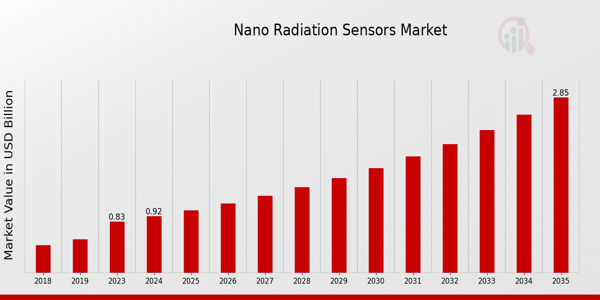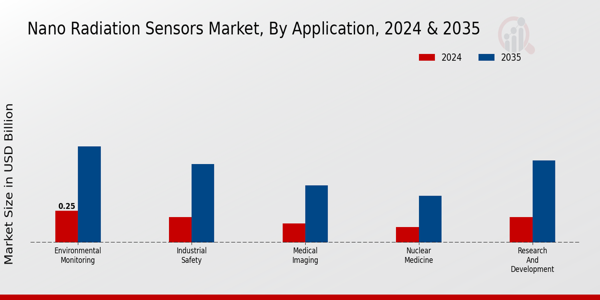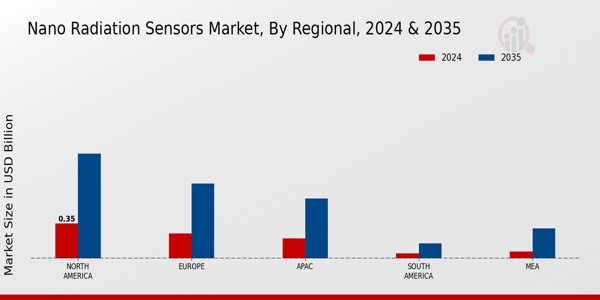Global Nano Radiation Sensors Market Overview
The Nano Radiation Sensors Market Size was estimated at 0.83 (USD Billion) in 2023. The Nano Radiation Sensors Market Industry is expected to grow from 0.92 (USD Billion) in 2024 to 2.85 (USD Billion) by 2035. The Nano Radiation Sensors Market CAGR (growth rate) is expected to be around 10.83% during the forecast period (2025 - 2035).
Key Nano Radiation Sensors Market Trends Highlighted
The Global Nano Radiation Sensors Market is influenced by several key drivers that are shaping its growth. One significant driver is the increased awareness and need for radiation safety in various industries, including healthcare and energy. As concerns over radiation exposure rise, there is a greater demand for advanced sensing technology that offers precise measurements. Furthermore, the growing applications of nanotechnology in sensor development lead to enhanced performance and miniaturization, making these sensors more appealing to end-users. The adoption of stringent safety regulations and standards across sectors also boosts the need for reliable radiation monitoring solutions.There are numerous opportunities within the global market that businesses can explore. The expansion of industrial sectors, especially in developing regions, presents opportunities for the deployment of nano radiation sensors in areas such as construction and manufacturing. Advancements in technology also allow for the integration of these sensors into broader IoT ecosystems, opening new avenues for real-time monitoring and data analysis. Additionally, as public safety concerns increase due to events like nuclear accidents or mishandling of radioactive materials, the demand for reliable radiation sensors will expand, providing a fertile ground for new innovations and business models.In recent times, there has been a noticeable trend towards the development of portable and user-friendly radiation sensors. These devices cater to both professional environments and consumer markets, emphasizing accessibility and ease of use. The rise of smart technologies has fostered innovative designs that incorporate features like wireless connectivity and remote monitoring capabilities. Companies are focusing on enhancing the functionality of these sensors to appeal to a broader audience, including researchers, hobbyists, and safety professionals. Overall, the growing interest in sustainable tech and public health consciousness is driving the evolution of the global Nano Radiation Sensors market.

Source: Primary Research, Secondary Research, MRFR Database and Analyst Review
Nano Radiation Sensors Market Drivers
Increasing Demand for Radiation Protection and Safety Measures
The concern over the adverse consequences of radiation exposure is becoming more reported. Thus driving the growth of the Global Nano Radiation Sensors Market. No doubt, with the advances in technology, the probability of radiation exposure is greater than ever; hence, the demand for efficient monitoring systems is also greater. Even though the demand for nano radiation sensors is also increasing, their sales are expected to rise more dramatically as healthcare, nuclear power, and, indeed, research laboratories are required by law and business to implement more stringent limits and improve safety procedures.
With these systems integrating seamlessly into employee's existing frameworks, the switch is easy. This change, coupled with advancements in nanotechnology, drives the adoption of Nanorad's offer. The integration further increases the protection of employees and the environment, which, in the end, benefits everyone. These changes are increasingly being promoted by the government coupled with the rising public interest, making workplaces and communities far safer.
Over the past few years, the Global Nano Radiation Sensors Market has been growing at a faster pace owing to a greater anticipated market valuation, which underscores the increased investment in safety technologies and radiation detection devices. Investment possibilities can be seen in an array of fields such as medical imaging, medical treatment, environmental surveillance, and even the operations of nuclear plants, where radiation detection and monitoring is a key focus area. As these government agencies and organizations move towards more stringent radiation safety regulations and policies, the dependency on nano sensors innovation will be drastic, which will push the need and investment for these solutions.
Technological Advancements in Sensor Design
The innovation occurring in sensor design, driven by advancements in nanotechnology, is a crucial factor contributing to the growth of the Global Nano Radiation Sensors Market Industry. These technological developments have significantly improved the performance characteristics of radiation sensors, making them more efficient and reliable. Features such as enhanced detection capabilities at lower radiation levels, compact size, and energy efficiency are becoming increasingly attractive to various sectors.As industries look for more sophisticated ways to monitor radiation, the role of innovative sensor designs becomes apparent. This trend not only empowers existing applications but also opens doors to new potential markets, thereby expanding the overall market landscape.
Growing Applications Across Various Industries
The versatility of nano radiation sensors has led to their widespread adoption across multiple industries, propelling the Global Nano Radiation Sensors Market Industry forward. As technology evolves, so too do the applications of these sensors; industries ranging from healthcare to nuclear power are recognizing the value of accurate radiation detection and measurement. In hospitals, for instance, nano radiation sensors play a vital role in radiological safety, ensuring that both patients and medical personnel are protected from unnecessary radiation exposure.Similarly, in the nuclear energy sector, these sensors are essential for monitoring radiation levels and maintaining safety standards. This expansion across diverse sectors underscores the robustness of the market and its capacity to adapt to varied needs based on industry requirements.
Nano Radiation Sensors Market Segment Insights :
Nano Radiation Sensors Market Application Insights
The Global Nano Radiation Sensors Market is experiencing a significant evolution, particularly in the Application segment, which encompasses critical areas such as Environmental Monitoring, Industrial Safety, Medical Imaging, Nuclear Medicine, and Research and Development. In 2024, the market for Environmental Monitoring will be valued at 0.25 USD Billion, indicating its essential role in tracking environmental radiation levels, thereby ensuring public safety and ecological preservation. This segment showcases considerable growth potential as environmental legislation becomes more stringent, promoting advancements in sensor technologies to enhance detection capabilities. Industrial Safety follows closely, valued at 0.20 USD Billion in 2024, emphasizing the importance of radiation safety protocols in various industries, especially those dealing with radioactive materials. The increasing awareness of workplace safety and stringent regulations contribute to this segment's expansion as organizations seek to minimize health risks for employees. Medical Imaging is also a critical application in this market, valued at 0.15 USD Billion in 2024. The role of nano radiation sensors in diagnostics, particularly in imaging techniques like PET and CT scans, cannot be understated. These sensors improve image quality and patient safety by refining radiation dosage, making this segment notable for ongoing innovation and clinical relevance. Moreover, Nuclear Medicine, valued at 0.12 USD Billion in 2024, utilizes these sensors to enhance the detection of radiopharmaceuticals and improve treatment efficacy for diseases such as cancer. The growing prevalence of nuclear therapies bolsters the importance of this segment in the healthcare industry. Lastly, the Research and Development application is valued at 0.20 USD Billion in 2024, showcasing the critical investments in technology to further enhance sensor performance and capabilities. Researchers utilize advanced nano radiation sensors to explore new applications and technologies, thereby driving innovation in the broader market. Overall, each application within the Global Nano Radiation Sensors Market provides significant opportunities for growth and development, underpinned by increasing demand for safety, efficiency, and precision across various industries.

Source: Primary Research, Secondary Research, MRFR Database and Analyst Review
Nano Radiation Sensors Market Technology Insights
The Global Nano Radiation Sensors Market is poised for substantial growth, with a valuation of 0.92 billion USD expected by 2024. This market encompasses various technologies, each contributing uniquely to its overall dynamics. Semiconductor Sensors are gaining traction due to their high sensitivity and compact size, making them suitable for various applications, including environmental monitoring and medical diagnostics. Photodetector Sensors also play a pivotal role, offering efficient detection of a wide range of radiation types, which positions them favorably in both industrial and safety applications.Scintillation Sensors are significant for their ability to provide real-time monitoring, which is crucial in nuclear power and medical imaging fields. Gas-Filled Detectors, characterized by their robustness and reliability, dominate in radiation protection applications across multiple industries. The diverse technologies within the Global Nano Radiation Sensors Market highlight the growing emphasis on safety and monitoring, fueled by increasing regulatory requirements and advancements in detection capabilities. This segment is driven by the rising demand for precision in radiation measurement, positioning it as a crucial area for future development within the market landscape.
Nano Radiation Sensors Market End Use Insights
The Global Nano Radiation Sensors Market is poised for substantial growth, reflecting a broader market value of 0.92 billion USD by 2024. Within the End Use segment, various sectors exhibit notable demand for these sensors. The healthcare industry is becoming increasingly reliant on precise radiation monitoring for therapeutic and diagnostic applications, which enhances patient safety. Nuclear power plants are critical users as well, where continuous monitoring ensures safety standards and operational efficiency, given the potential risks associated with radiation.Research institutions also represent a significant marketplace, utilizing these sensors for various experimental applications and safety protocols. Moreover, manufacturing facilities, particularly those dealing with radioactive materials, benefit from advanced detection capabilities to maintain compliance with safety regulations. The diverse applications across these fields underscore the importance of nano radiation sensors in promoting safety and efficacy, confirming their vital role in addressing the specific needs of each sector, thus driving the Global Nano Radiation Sensors Market revenue and enhancing growth dynamics.
Nano Radiation Sensors Market Region Insights
The Global Nano Radiation Sensors Market exhibited significant growth, showing a valuation of 0.92 USD Billion in 2024. The market growth is driven by increasing awareness regarding radiation safety and advancements in technology. Specifically, North America is a key player, characterized by robust investments in research and development in radiation sensors. Europe holds a substantial market share, benefiting from stringent regulations concerning radiation monitoring and safety. In the Asia-Pacific region, rapid industrialization and urbanization are prompting a rise in the demand for nano radiation sensors, making it a rapidly growing area of focus.Latin America is also emerging with a growing need for radiation detection in the healthcare and environmental sectors. The Global Nano Radiation Sensors Market statistics indicate that the continuous investment in infrastructure, particularly in healthcare and environmental applications, presents considerable opportunities across all regions, although challenges such as high initial costs may impact growth trends. Rising applications in defense and nuclear industries further emphasize the importance of these markets in the global landscape.
Nano Radiation Sensors Market Regional Insights
The Global Nano Radiation Sensors Market, with a projected valuation of 0.92 USD Billion in 2024, showcases various regional dynamics that highlight significant growth potential. North America leads the way with a valuation of 0.35 USD Billion in 2024, exemplifying its majority holding due to high investment in advanced technologies and radiation safety. Europe follows, valued at 0.25 USD Billion, where increasing concerns regarding radiation in medical and industrial applications fuel demand. The APAC region, valued at 0.20 USD Billion, is emerging rapidly as its governments are prioritizing innovations in safety and health monitoring, thus displaying considerable market growth.South America, with a valuation of 0.05 USD Billion, and the MEA region, at 0.07 USD Billion, represent smaller segments, but opportunities for growth exist as awareness of radiation protection increases. Overall, the Global Nano Radiation Sensors Market statistics reflect strong regional variance influenced by economic conditions, regulatory measures, and technological advancements tailored to each area's specific needs. This segmentation helps identify key areas of investment and market penetration efforts, driving overall market growth.

Source: Primary Research, Secondary Research, MRFR Database and Analyst Review
Nano Radiation Sensors Market Key Players and Competitive Insights :
The Global Nano Radiation Sensors Market is currently witnessing significant developments driven by technological advancements, increasing safety regulations, and heightened awareness regarding radiation exposure. Companies in this market are focusing on innovative designs and efficient performance to capture a larger market share. Competitive strategies include product diversification, strategic partnerships, and collaborations aimed at enhancing product offerings and expanding geographical reach. The growing demand for portable and real-time radiation detection solutions across various applications, including medical diagnostics, environmental monitoring, and nuclear power plants, is propelling market participants to invest in research and development. This increasingly competitive landscape compels companies to adapt quickly to changing market conditions while emphasizing sustainability and compliance with international standards.Radiation Detection Company has established a strong presence in the Global Nano Radiation Sensors Market through its commitment to delivering cutting-edge technology and superior customer service. The company's strengths lie in its extensive research capabilities, enabling it to develop highly sensitive nano radiation sensors tailored for various applications. The ability to leverage advanced materials science and engineering allows Radiation Detection Company to produce sensors that offer high accuracy and reliability. Additionally, their well-established distribution network and collaboration with key stakeholders enhance their market accessibility. The company also benefits from an experienced workforce that drives innovation and maintains quality, putting it at the forefront of the nano radiation sensor space.Thermo Fisher Scientific operates with a robust market strategy in the Global Nano Radiation Sensors Market, continuously focusing on advancements in detection technology and user-friendly designs. Renowned for its strong brand presence, Thermo Fisher Scientific boasts a diverse portfolio of nano radiation sensors catering to both commercial and industrial applications. Their strengths include an extensive range of products that meet diverse customer needs, combined with a reputation for high-quality manufacturing. The company invests heavily in research and development, ensuring that its products remain at the cutting edge of technology. Furthermore, Thermo Fisher Scientific’s commitment to sustainability and compliance with global safety standards positions it as a trustworthy leader in the market, fostering long-term relationships with customers and stakeholders alike.
Key Companies in the Nano Radiation Sensors Market Include:
- Radiation Detection Company
- Thermo Fisher Scientific
- LND, Inc.
- Gilsal Company
- Siemens
- Canberra Industries
- Kromek Group
- Fluke Corporation
- Sensus
- Landauer
- Applied Radiation Inc.
- Ruppert, Inc.
- Ametek
- Honeywell
- Mirion Technologies
Nano Radiation Sensors Industry Developments
Recent developments in the Global Nano Radiation Sensors Market indicate a growing emphasis on technological advancements and strategic collaborations among key players such as Radiation Detection Company, Thermo Fisher Scientific, and Mirion Technologies. The market is witnessing an increasing demand for enhanced safety measures in various sectors, including healthcare, nuclear energy, and environmental monitoring. Notably, the acquisition of smaller firms by major players like Siemens and Canberra Industries reflects a trend toward consolidation, fostering innovation and efficiency in product offerings. Additionally, Kromek Group and Landauer have reported advancements in sensor accuracy and integration with digital platforms, which bolsters the effectiveness of radiation detection. The market valuation of companies like Ametek and Honeywell has seen growth due to the rising awareness of radiation hazards and regulatory compliance in industries. Furthermore, investments in research and development are propelling new sensor technologies, addressing the need for portable and reliable radiation detection tools. Overall, these developments illustrate a vibrant and evolving environment in the Global Nano Radiation Sensors Market, underscoring the competitive landscape among established and emerging entities.
Nano Radiation Sensors Market Segmentation Insights
Nano Radiation Sensors Market Application Outlook
- Environmental Monitoring
- Industrial Safety
- Medical Imaging
- Nuclear Medicine
- Research and Development
Nano Radiation Sensors Market Technology Outlook
- Semiconductor Sensors
- Photodetector Sensors
- Scintillation Sensors
- Gas-Filled Detectors
Nano Radiation Sensors Market End Use Outlook
- Healthcare
- Nuclear Power Plants
- Research Institutions
- Manufacturing Facilities
Nano Radiation Sensors Market Region Outlook
- North America
- Europe
- Asia-Pacific
- Latin America
Scope:
| Attribute/Metric Source: |
Details |
| MARKET SIZE 2023 |
0.83 (USD Billion) |
| MARKET SIZE 2024 |
0.92 (USD Billion) |
| MARKET SIZE 2035 |
2.85 (USD Billion) |
| COMPOUND ANNUAL GROWTH RATE (CAGR) |
10.83% (2025 - 2035) |
| REPORT COVERAGE |
Revenue Forecast, Competitive Landscape, Growth Factors, and Trends |
| BASE YEAR |
2024 |
| MARKET FORECAST PERIOD |
2025 - 2035 |
| HISTORICAL DATA |
2019 - 2024 |
| MARKET FORECAST UNITS |
USD Billion |
| KEY COMPANIES PROFILED |
Radiation Detection Company, Thermo Fisher Scientific, LND, Inc., Gilsal Company, Siemens, Canberra Industries, Kromek Group, Fluke Corporation, Sensus, Landauer, Applied Radiation Inc., Ruppert, Inc., Ametek, Honeywell, Mirion Technologies |
| SEGMENTS COVERED |
Application, Technology, End Use, Region, Regional |
| KEY MARKET OPPORTUNITIES |
Growing demand for environmental monitoring, Advances in healthcare applications, Increasing regulations for radiation safety, Expansion in nuclear energy sector, Development of wearable radiation sensors |
| KEY MARKET DYNAMICS |
Technological advancements in sensors, Growing safety regulations and standards, Increasing demand for environmental monitoring, Rising applications in healthcare, Expansion of nuclear energy sector |
| COUNTRIES COVERED |
North America, Europe, APAC, South America, MEA |
Frequently Asked Questions (FAQ) :
The Global Nano Radiation Sensors Market is expected to be valued at 0.92 USD Billion in 2024.
By 2035, the Global Nano Radiation Sensors Market is projected to reach a value of 2.85 USD Billion.
The expected CAGR for the Global Nano Radiation Sensors Market from 2025 to 2035 is 10.83%.
North America is projected to have the largest market size in 2035, with a value of 1.05 USD Billion.
The Environmental Monitoring application in the Global Nano Radiation Sensors Market is expected to be valued at 0.76 USD Billion in 2035.
Key players in the Global Nano Radiation Sensors Market include Radiation Detection Company, Thermo Fisher Scientific, and Siemens.
The Medical Imaging application of the Global Nano Radiation Sensors Market is expected to be valued at 0.15 USD Billion in 2024.
The Industrial Safety application is projected to reach a value of 0.62 USD Billion in 2035.
The market size for South America is expected to be 0.05 USD Billion in 2024.
Growth opportunities in the Global Nano Radiation Sensors Market include advancing technology in environmental monitoring and medical imaging applications.
















